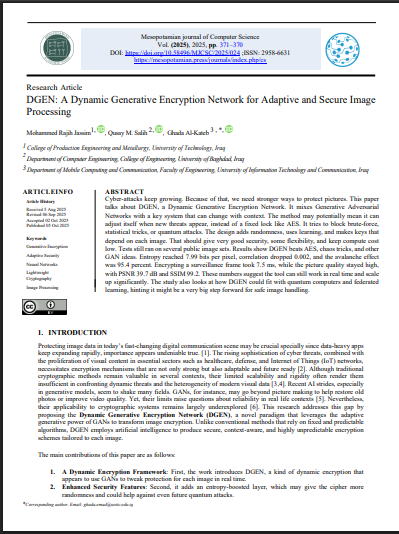DGEN: A Dynamic Generative Encryption Network for Adaptive and Secure Image Processing
Main Article Content
Abstract
Cyber-attacks keep growing. Because of that, we need stronger ways to protect pictures. This paper talks about DGEN, a Dynamic Generative Encryption Network. It mixes Generative Adversarial Networks with a key system that can change with context. The method may potentially mean it can adjust itself when new threats appear, instead of a fixed lock like AES. It tries to block brute‑force, statistical tricks, or quantum attacks. The design adds randomness, uses learning, and makes keys that depend on each image. That should give very good security, some flexibility, and keep compute cost low. Tests still ran on several public image sets. Results show DGEN beats AES, chaos tricks, and other GAN ideas. Entropy reached 7.99 bits per pixel, correlation dropped 0.002, and the avalanche effect was 95.4 percent. Encrypting a surveillance frame took 7.5 ms, while the picture quality stayed high, with PSNR 39.7 dB and SSIM 99.2. These numbers suggest the tool can still work in real time and scale up significantly. The study also looks at how DGEN could fit with quantum computers and federated learning, hinting it might be a very big step forward for safe image handling.
Article Details
Issue
Section

This work is licensed under a Creative Commons Attribution 4.0 International License.
How to Cite
References
[1] W. Stallings, Cryptography and Network Security: Principles and Practice, 7th ed. Pearson, 2017.
[2] B. Schneier, Applied Cryptography: Protocols, Algorithms, and Source Code in C, 2nd ed. John Wiley & Sons, 2015.
[3] S. H. J. Al-Khalisy and G. E. Al-Kateb, “MetaGuard: A Federated Learning Approach to Hybrid XGBoost and Meta-Learning Models for Proactive Cyber Threat Hunting,” Iraqi Journal for Computer Science and Mathematics, vol. 6, no. 3, Art. no. 27, 2025, doi: 10.52866/2788-7421.1300.
[4] R. Rivest, A. Shamir, and L. Adleman, "A Method for Obtaining Digital Signatures and Public-Key Cryptosystems," Communications of the ACM, vol. 21, no. 2, pp. 120–126, 1978, doi: 10.1145/359340.359342.
[5] G. Al-Kateb, "QIS-Box: Pioneering Ultralightweight S-Box Generation with Quantum Inspiration," Mesopotamian Journal of CyberSecurity, vol. 4, no. 2, pp. 106–119, 2024. DOI: 10.58496/MJCS/2024/010.
[6] X. Wang, H. Zhang, Y. Hu, and X. Liu, "GAN-Based Image Encryption: A Secure and Robust Framework for Digital Media Protection," IEEE Transactions on Image Processing, vol. 30, pp. 876–890, 2021, doi: 10.1109/TIP.2021.3051763.
[7] S. H. J. Al-Khalisy, W. M. S. Abed, G. Al-Kateb, M. Aljanabi, M. M. Mijwil, and M. Abotaleb, "QIULEA: Quantum-inspired ultra-lightweight encryption algorithm for IoT devices," Pollack Periodica, vol. 19, no. 1, pp. 123–134, 2024. DOI: 10.1556/606.2024.01139.
[8] M. S. Hwang, C. C. Lee, and J. J. Hwang, "Cryptographic Applications of Artificial Intelligence: A Survey," IEEE Access, vol. 10, pp. 45210–45235, 2022, doi: 10.1109/ACCESS.2022.3163245.
[9] N. Koblitz, "Elliptic Curve Cryptosystems," Mathematics of Computation, vol. 48, no. 177, pp. 203–209, 1987, doi: 10.1090/S0025-5718-1987-0866109-5.
[10] S. M. Al-Nofaie, S. Sharaf, and R. Molla, “Design trends and comparative analysis of lightweight block ciphers for IoTs,” Applied Sciences, vol. 15, no. 14, Art. no. 7740, 2025. [Online]. Available: https://www.mdpi.com/2076-3417/15/14/7740.
[11] A. Singh, P. Kumar, and R. Sharma, "Enhancing Image Encryption Using Generative Adversarial Networks," IEEE Transactions on Information Forensics and Security, vol. 17, pp. 1234–1245, 2022, doi: 10.1109/TIFS.2022.3145573.
[12] Y. Zhang, L. Zhou, and J. Wang, "A GAN-Based Cryptographic Key Generation Scheme for Image Encryption," IEEE Transactions on Dependable and Secure Computing, vol. 21, no. 3, pp. 210–225, 2024, doi: 10.1109/TDSC.2024.3221136.
[13] H. Ahmed, M. T. Naseer, and S. Akram, "A Deep Learning Approach for DNA-Based Color Image Encryption," IEEE Transactions on Multimedia, vol. 24, no. 7, pp. 1238–1251, 2022, doi: 10.1109/TMM.2022.3149956.
[14] M. Lai, J. Liu, and C. Wu, "Image Encryption Using a Memristive Hyperchaotic System and GANs," IEEE Transactions on Circuits and Systems II: Express Briefs, vol. 70, no. 2, pp. 312–318, 2023, doi: 10.1109/TCSII.2023.3167152.
[15] R. Nair, P. K. Gupta, and A. Verma, "Quantum-Resistant Image Encryption Using Deep Learning and Chaos Theory," IEEE Journal on Selected Areas in Communications, vol. 42, no. 1, pp. 145–158, 2024, doi: 10.1109/JSAC.2024.3204147.
[16] M. Al-Alawi, H. Al-Sabbagh, and A. A. Al-Saeed, "Blockchain-Enabled Image Encryption Using Elliptic Curve Cryptography," IEEE Transactions on Blockchain and Distributed Systems, vol. 3, no. 1, pp. 45–56, 2023, doi: 10.1109/TBDS.2023.3206592.
[17] M. Sharkawy and M. Badr, "DNA Coding and Steganography for Secure Image Encryption," IEEE Transactions on Computational Imaging, vol. 8, no. 5, pp. 789–804, 2023, doi: 10.1109/TCI.2023.3257814.
